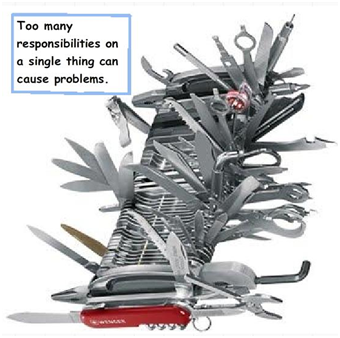SOLID Tutorials
Understanding “S”- SRP (Single responsibility principle)
The best way to understand SOLID is by understanding what problem it tries to solve. Have a look at the code below, can you guess what the problem is ?( You are not going to get BEER to guess it J , because it’s too simple).
OK, let me give a HINT look at the catch block code.
class Customer
{
public void Add()
{
try
{
// Database code goes here
}
catch (Exception ex)
{
System.IO.File.WriteAllText(@"c:\Error.txt", ex.ToString());
}
}
}
The above
Customer class is doing things WHICH HE IS NOT SUPPOSED TO DO. Customer class should do customer datavalidations, call the customer data access layer etc , but if you see the catch block closely it also doing LOGGING activity. In simple words its over loaded with lot of responsibility.
So tomorrow if add a new logger like event viewer I need to go and change the “Customer”class, that’s very ODD.
It’s like
if “JOHN” has a problem why do I need to check “BOB”.

This also reminds me of the famous swiss knife. If one of them needs to be changed the whole set needs to be disturbed. No offense I am great fan of swiss knifes.

But if we can have each of those items separated its simple, easy to maintain and one change does not affect the other. The same principle also applies to classes and objects in software architecture.

So SRP says that a class should have only one responsibility and not multiple.So if we apply SRP we can move that logging activity to some other class who will only look after logging activities.
class FileLogger
{
public void Handle(string error)
{
System.IO.File.WriteAllText(@"c:\Error.txt", error);
}
}
Now customer class can happily delegate the logging activity to the “FileLogger” class and he can concentrate on customer related activities.
class Customer
{
private FileLogger obj = new FileLogger();
publicvirtual void Add()
{
try
{
// Database code goes here
}
catch (Exception ex)
{
obj.Handle(ex.ToString());
}
}
}
Now architecture thought process is an evolution. For some people who are seniors looking at above SRP example can contradict that even the try catch should not be handled by the customer class because that is not his work.
Yes, we can create a global error handler must be in theGlobal.asax file , assuming you are using ASP.NET and handle the errors in those section and make the customer class completely free.
So I will leave how far you can go and make this solution better but for now I want to keep this simple and let your thoughts have the freedom to take it to a great level.




